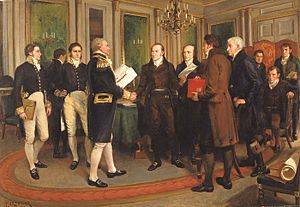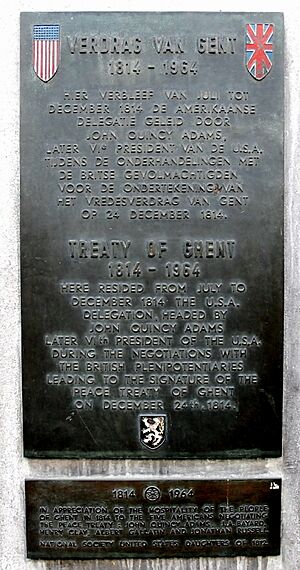Treaty of Ghent facts for kids

The Treaty of Ghent was a very important peace treaty. It officially ended the War of 1812. This war was fought between the United States and the United Kingdom. The treaty was signed on December 24, 1814. It happened in the city of Ghent, which is in the Flemish Region of Belgium. This agreement made things go back to how they were before the war started.
The treaty was approved by the British Parliament on December 30, 1814. The Prince Regent, who later became King George IV, signed it into law. Even though the treaty was signed, news traveled slowly. An American army led by Andrew Jackson won a big battle, the Battle of New Orleans, in early January 1815. The treaty officially started only after the United States Senate approved it. They voted yes unanimously in February 1815.
Contents
What Was the Treaty of Ghent?
The Treaty of Ghent was the agreement that brought peace. It stopped the fighting in the War of 1812. This war had been going on for over two years. The treaty was named after the city where it was signed. Ghent is a city in what is now Belgium.
Why Was the Treaty Needed?
Both sides were tired of fighting. The war had cost a lot of money and lives. The United States and the United Kingdom decided it was time to talk about peace. They sent representatives to Ghent to negotiate. These representatives were called "plenipotentiaries."
Key Points of the Treaty
The main goal of the treaty was to end the war. It did not really declare a winner. Instead, it focused on returning things to how they were. This is often called "status quo ante bellum." It means "the way things were before the war."
- Borders Restored: The treaty made sure that the borders between the United States and British North America (now Canada) went back to their original lines. No land changed hands.
- Prisoners Returned: Both countries agreed to return all prisoners of war.
- Native American Lands: The treaty also mentioned Native American tribes. It said they should get back their lands. However, this part was often ignored later.
The Signing and Approval Process
Signing a treaty is just the first step. It then needs to be approved by the governments. This process is called ratification. It makes the treaty official and legally binding.
Signing in Ghent
The treaty was signed on Christmas Eve, 1814. Representatives from both countries met in Ghent. The American team included John Quincy Adams, who later became president. The British team included important diplomats. They worked for weeks to agree on the terms.
Ratification by Governments
After signing, the treaty went to London for British approval. The British Parliament quickly ratified it. Then, it traveled across the Atlantic to the United States. The United States Senate had to approve it there. They voted unanimously in February 1815. This final approval made the treaty officially active.
Impact and Legacy
The Treaty of Ghent ended a war. But it also helped shape the future of North America. It led to a long period of peace between the United States and the British Empire.
A Lasting Peace
Even though the war ended with no clear winner, the treaty led to lasting peace. The United States and Canada, which was then British North America, began to develop a peaceful border. This border is now the longest undefended border in the world.
The Peace Bridge
A symbol of this peace is the Peace Bridge. It connects Buffalo, New York, in the United States, with Fort Erie, Ontario, in Canada. It stands as a reminder of the peace that followed the Treaty of Ghent.
Images for kids
See also
 In Spanish: Tratado de Gante para niños
In Spanish: Tratado de Gante para niños



